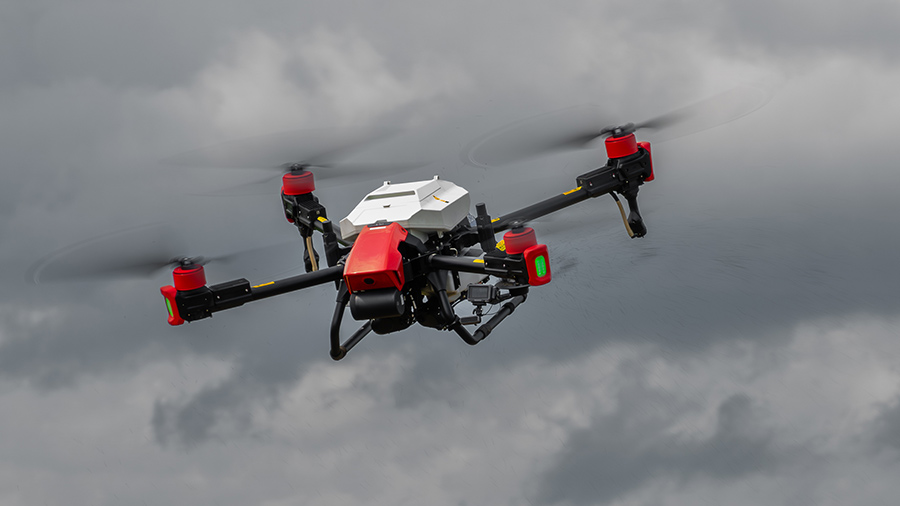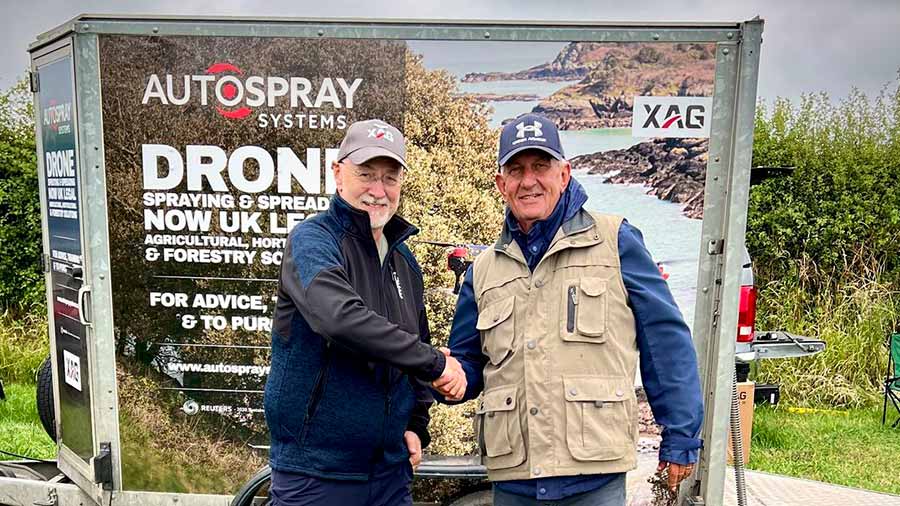Olly Harrison sows OSR and cover crop with quadcopter drone
 © Quadrotor Services
© Quadrotor Services Merseyside arable farmer and agricultural YouTuber Olly Harrison planted a 1ha segment of oilseed rape via aerial application with a quadcopter drone.
The P40 XAG drone also broadcast a cover crop of phacelia and mustard into a standing crop of winter wheat, before the cereal was even harvested.
Operating at an average speed of 7.7m/second, with a 25kg hold capacity, the drone was supplied by Agricultural drone service company Quadrotor Services.
“We did three passes spreading the oilseed rape at a width of 8m and flew 6-7m above the ground. This took just under three minutes to complete,” says Olly.
See also: New drone course takes flight at UK agricultural university
Sow 20ha in one hour
Peter Johnson co-founder of the firm explains that under optimum conditions dependent on wind speed, width of spread and drone weight, the device can fly up to an impressive 12m/sec. This is the equivalent of 20ha/hour which includes recharge time.
“Users can expect a battery life of about 10 minutes and a full recharge time of 8 minutes.
“The drone will fly back to base at 25% battery life, where we rotate a number of batteries and fit a new one in less than 60 seconds – it’s like a Formula One pitstop,” says Peter.
The machine is simple to use and is controlled via an app on a mobile phone or tablet. The drone costs about £27,000 plus VAT, which means you could get a fleet of drones for a fraction of the cost of a tractor and drill.
A larger 55kg hold capacity drone is also available, costing about £35,000 plus VAT.
The dos and don’ts of drones
Current UK legislation prohibits aerial application of any product which comes with a map number, which includes all herbicide, fungicide and insecticide sprays.
Fungicide seed treatments are also prohibited so undressed seed was sourced.
As the drone spreads at a rate of 10kg/ha and the OSR was spread at 2.1kg/ha, the rate was made up with 7.9kg/ha of urea starter fertiliser.
Furthermore, drones are not permitted to fly within 50m of uninvolved participants or fly as a swarm, hence Olly used the drone to plant a segment in the middle of the field.
Furthermore, only one drone is permitted to be flown per operator.
“I can really see the advantages of planting crops with drones, as it’s a better use of time and can avoid soil compaction but the legislation is too far behind the technology. This really needs to catch up if we are to scale-up,” says Olly.
If aerial establishment proves successful, Olly’s next step will be establishing a crop of millet into a standing crop of winter barley with the drone next June in order to gain an extra crop from the rotation.
Plans for slug pellets and glyphosate aerial applications
Aerial application of slug pellets and glyphosate sprays for control of bracken, blackgrass and Japanese knot weed control are nearing UK approval.
Agricultural drone service company Quadrotor Services and UK drone importer Autospray Systems are currently seeking licence approval from the CRD for a number of drone-use extensions.
Rob Pearson, chief executive officer of Autospray Systems explains that drone legislation is gaining momentum.
“We first imported drones into the UK in 2019, working closely with Chinese drone manufacturer XAG. Since then, we’ve made incredibly slow progress – but now we have government on our side, we’re gaining momentum.
“We’ve successfully got drones legal to fly here in the UK, so the next step is getting pesticides approved which we are well advanced on.
“It is no longer a question of will we able to make aerial glyphosate applications, but more of a question of when and what will the buffer zone requirements be?” he says.
Quadrotor Services’ Peter Johnson is hopeful the slug pellet licence will be approved within the next four weeks, with movement on glyphosate spraying by the end of this year.
Drone services currently on offer by Quadrotor Services

Kevin Gornall and Peter Johnson, founders of Quadrotor Services © Quadrotor Services
- Crop sowing and fertiliser spreading – currently have a 300ha reseeding job planting Birch trees on the west coast of Scotland
- Multispectral crop monitoring – with plans for spot-spraying once legislation permits
- Cleaning and shading horticultural glasshouses – capable of cleaning up to 4ha of glasshouses in one day with a single drone

